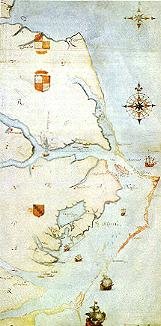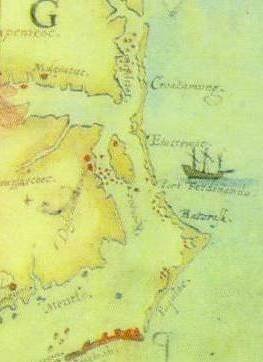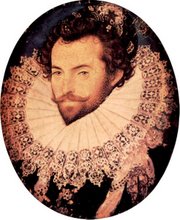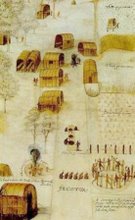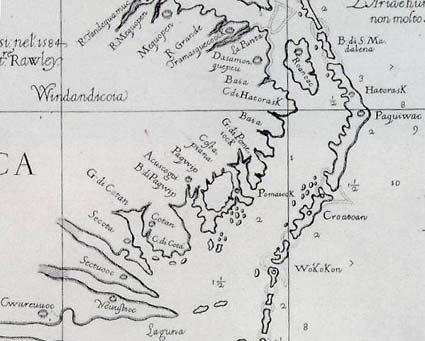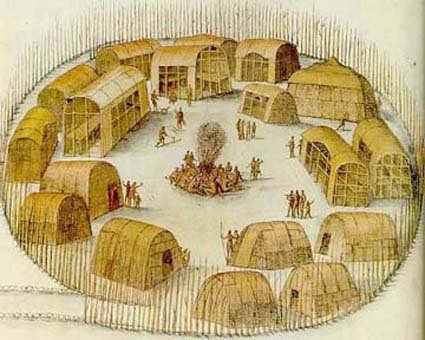Melungeon Myth of Drake Dropping off Passengers on Roanoke
By Janet Lewis Crain
A myth exists on the Internet that the Melungeons, a group of dark skinned
persons of mysterious origins found living in East Tennessee two hundred
years ago descend from Turkish prisoners and sundry other non-English persons
said to have been rescued by Sir Francis Drake during the sacking of Cartagena and
then deserted on Roanoke Island in 1586. In truth, there is NO evidence there
were any left behind there, much less several hundred. This myth was introduced
in a book published in the 1990's by Brent Kennedy titled The Melungeons:
The Resurrection of a Proud People : An Untold Story of Ethnic Cleansing in
America.
This book might have lanquished in obscurity on the shelves of a few Libraries
and book stores had it not been for the Internet and the new found surge
of interest in genealogy. Suddenly everyone fancied him or herself a Melungeon.
Several Unions were held of people from various mailing lists and persons attending
were happily discovering knots.on the back of their head, thought to indicate
Turkish ancestry. Having someone in your Family tree who possessed six
fingers was a definite plus. These traits were all described in the afore mentioned book.
No one ever looked too closely into the incident said to have occurred in 1586. But
that is precisely what this paper intends to do.
In the sixteenth century, Sir Francis Drake was one of the most famous men in England, indeed the English speaking world and beyond. He could do no wrong in his Queen's eyes. He had brought her an enormous return on her personal investment in an earlier voyage. A brilliant man in many ways, Drake was ruthless, but highly admired by the captives he had freed and the Maroons who came to his aid to help him fight and share in the rewards.
Drake was returning home from the sacking of Cartagena when he decided to
visit Roanoke and dispose of some of the freed prisoners and Maroons he had
acquired during his adventures. He was carrying a human cargo of some several hundred. Ivor Noel Hume in "Virginia Adventures" contends Drake
highly inflated the numbers. The voyage had not been financially successful
in spite of his daring and flamboyant actions. It is quite likely he was
advancing his case by sending back reports of greater exploits than actually
had occurred. There were reports of many nationalities released from the
Spanish prisons as well as Maroons who had come in from their strongholds in
the surrounding areas to help Drake as he was known to be generous with the
spoils of his marauding. Alas this voyage would not compare to previous ones.
This voyage is of great interest to Melungeon researchers because this
voyage in 1586 is the basis of the Turkish connection first started by
statements in Brent Kennedy's book: Melungeons; an Untold Story of Ethnic
Cleansing. It is, in fact, the keystone of the Turkish Connection Theory.
Remove it and the rest crumbles. That is what I propose to do.
It is known that many of the people with him never reached Roanoke. Many died of
strange fevers in Florida. These fevers were the scourge of sea travel at
that time. Caused in part by the crowding together of humans in the cargo
holds of ships where the fetid air trapped and spread any contagious
disease like wildfire, and probably acerbated by nutritional deficiencies.
In any case, reports contend that anywhere between 350 and 750 people died of
these fevers. Apparently Drake intended to leave the rest of the freed
Africans and South American Indians to furnish labor for the new Colony on
Roanoke which he expected to have grown to some 600 English by then. In
truth There were only about 100 men, badly in need of food and suffering the
ill effects of their bad treatment of the local Indians. Ralph Lane was in
charge at Roanoke and he accepted Drake's offer of minimal food supplies
(Drake had been out a long time and was running low himself) and a ship, the
Francis, capable of navigation into the bay plus other pinnaces, etc. and
armament. All the supplies were loaded onto the Francis along with Lane's
best naval officers. Lane wanted to stay a few more weeks exploring the
Chesapeake.
Hume states:
When on June 11, the two men (Francis Drake and Ralph Lane) exchanged their
unsettling news, several truths became evident; Drake was not there (as the
Roanoke settlers had first hoped) to resupply the Colony; he was short of
food himself and so was better able to supply guns than butter. Futhermore,
Lane could not have had any desire or ability to house 250 blacks who would
out number his white settlers two to one.
They came to an agreement whereby Drake would leave skilled workers,
artisans, two pinnaces, several small boats and a large ship, the Francis.
All the supplies were loaded onto the Francis along with the skilled
mariners needed to sail such a ship. Immediately a terrible hurricano struck
and it was every man for himself. The ships standing out in the roadway cut
and ran, scurrying out to the deep ocean to get away from the treacherous
shoals and currents, dangerous enough in good weather. The Francis was among
those who sailed on to England.
Ralph Lane then accepted Drake's offer to transport the first colonists back
To England. Most of the small pinnaces carrying the extra passengers had
been dashed to pieces on the shoals during the storms. The Turks, known to
have been with Drake, were apparently better safeguarded. They were valuable
as trade for English prisoners lanquishing in Ottoman prisons. Some 100
Turks were, in fact, ransomed to their homeland.
So, just who might have gone ashore before the storm hit? Many people have a
hard time visualizing the scene at Roanoke. Roanoke is surrounded by very
shallow waters, hence the name; Shallowbag Bay. The only way to get there
was by laborious offloading of men and supplies to shore boats and threading
through the one pass, Fernando Pass, and the treacherous shoals and currents
made worse at times by Northwestern winds blowing directly into the Bay. The
shore boats were large by our standards and equipped with a mast and sail.
They require a skilled pilot and several strong sailors to row. People didn't
just hop on one and go sight seeing. Only those with important business
such as Sir Francis Drake and Ralph Lane who negotiated several times were
transported back and forth. The rest of the fleet with the passengers
onboard stood out in the Roadway, the navigable waters off the Outer Banks,
which wrap around this area like protecting arms.
I am saying this to lay to rest the idea of a huge number of the passengers
dis-embarking and perhaps being caught off guard by the storms and staying
behind. Hume and David Beers Quinn are the authorities on this period and
both say there were no Turks left. Hume says no one else, Quinn, at most a
very few. Left with no supplies on the Outer Banks what would they have
found to eat? If the Indians had not killed them, they would have starved.
It should be noted that the Native Americans communicated by a"grapevine" so
efficient that Indians in Canada knew of happenings in the Virginias. No
mention of any dumped off passengers was ever made.
Additionally, there was plenty of room for these passengers to sail with
Drake. Hundreds had died in the battles in Florida, from fevers, and in the
hurricane. Drake was returning with more ships than he left with, having
captured many. And they would have furnished badly needed labor to sail
these ships back to England.
Add to this the extreme difficulty of unloading these passengers in addition
to loading the Roanoke settlers, which the crew deeply resented for the
delay and extra work and danger this imposed and it is highly unlikely Drake
would have taken such actions in the middle of a three day hurricane.
Ivor Noel Hume says:
Thus the hurricane of June 1586 may have ripped away the first page from the
history of blacks in English America.
A cruel and terrible fate for these forgotten people that historians of the
time did not consider important enough to even record their fate.
Two weeks later an emergency supply ship sent by Sir Richard Grenville
arrived and found no one although they searched diligently. They left to return to England.
About one or two weeks later a big supply ship arrived with Grenville on
board. They were as mystified at the deserted condition of the island as the
men on the earlier supply ship. They searched even further "into the main"
(mainland) and as far as Chesapeake. Grenville was heavily invested in this
first effort, having sold an entire estate (consisting at this time as a
manor house and every type of supporting industry needed to run the estate;
mills, stables, barns, houses, dairies, animals, tools, even small villages)
to finance the settlement of over 100 men for over a year. It was a
requirement of Raleigh's patent from Queen Elizabeth that the area be
occupied continuously by English people. Finding no one and not knowing where
they had gone, he left some 15 soldiers to hold the fort. Based upon later
interviews with Indians, they all perished.
It is quite clear they found no one who could have been the passengers Drake
was previously carrying.
As previously stated the Indians had a very effective rumor mill which
carried news far and wide. It is just inconceivable that these
people could have survived unnoticed when their appearance would have been a
matter of great curiosity among people who had never seen African natives.
Thus it seems there is no evidence that any people were left behind in the Colony and documented evidence that 100 turks were returned to their homeland.
Resources:
The Virginia Adventurers by Ivor Noel Hume Copyright 1994 p. 53
Corbett, Spanish War. Refers to the return of 100 ex-galley slaves to the
Turkish dominions.
William S. Powell, North Carolina through Four Centuries, p. 42. Refers to
Queen Elizabeth's reason for returning the Turks.
David Beers Quinn, Roanoke Voyages. Cites Wright in footnote regarding Turks
Wright, Further English Voyages. Source of Quinn's information about Turks.
Hakluyt Society for 1975, Second Series, No. 148, p. 202, Note 3. Sir
Francis Drake's West Indian Voyage, 1585-1586. A detailed and authorative
account.
Acts of the Privey Council, 1586-87, PP. 205-206. (Public Record Office
[London]), PC 2/14:169) Contains a letter from the Queen's Privey Council
addressed to a merchant in London, who traded with Turkey, that asks him to
make arrangements for the return of 200 Turks to Turkey.
Document 10, The Primrose Journal (British Library Royal MS.7C,xvi, folders
166-173. Capt. Frobisher's journal of the 1586 Drake-led voyage. Mentions
Turks being aboard his ship.
David Beers Quinn Set Fair for Roanoke
David Beers Quinn The Roanoke Voyages 1584-1590
This blog is © History Chasers
Click here to view all recent Lost Colony Research Group Blog posts














